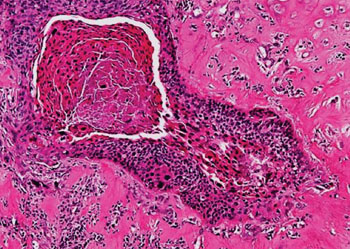Gene Predicts Outcomes for Head and Neck Patients
|
By LabMedica International staff writers Posted on 08 Mar 2016 |

Image: Histopathological findings in laryngeal squamous cell carcinoma (Photo courtesy of Nikon Microscopy).
A human cancer-causing gene, called the DEK oncogene (DEK), can be detected in the plasma of head and neck cancer patients and this may help doctors understand how a person's immune system could be used to treat cancer or predict outcomes for patients.
Head and neck cancers are strongly associated with certain environmental and lifestyle risk factors, including tobacco smoking, alcohol consumption, ultraviolet (UV) light, particular chemicals used in certain workplaces, and certain strains of viruses, such as human papilloma virus (HPV).
Scientists at the University of Cincinnati (OH, USA) collected whole blood from patients with newly diagnosed and untreated head and neck cancer or normal healthy participants who were the same age. Plasma was separated from the samples, and an enzyme-linked immunosorbent assay (ELISA), a test that uses antibodies and color change to identify a substance, was administered. Plasma DEK levels were compared to normal control levels, tumor stage, age and smoking status and these levels were also compared to inflammatory markers, which can signify cancer, in the plasma and tissue.
Trisha Wise-Draper, MD, PhD, assistant professor in the Division of Hematology Oncology and principal investigator of the study said, “Head and neck cancer remains the sixth most common cancer worldwide. One potential plasma biomarker is programmed by the human DEK gene, which has been found to promote cancer. DEK RNA and protein are highly increased in tissue specimens from several tumor types including head and neck cancer, breast cancer and melanoma, and antibodies to DEK are also detected in patients with autoimmune diseases like juvenile rheumatoid arthritis and lupus. Our previous work has shown that DEK is highly and universally present in head and neck cancer tissue specimens regardless of stage or HPV infection and has suggested tumor-association. In addition, white blood cells (macrophages) secrete DEK protein leading to the hypothesis that DEK may be present in the plasma of cancer patients and could be correlated with aggressiveness of disease and patient outcomes.”
Prof. Wise-Draper added, “We found that DEK was present in the plasma of both healthy control subjects and those with head and neck cancer. Overall, DEK was decreased in head and neck cancer patients compared to healthy patients, but it was inversely correlated with interleukin-6 (IL-6), which is secreted by T cells and triggers an immune response, in the plasma. The immune system's reaction to the tumor also appeared to be linked with high DEK plasma levels. So, although DEK presence is increased in head and neck cancer tissue, plasma DEK levels are decreased in patients when compared with healthy individuals and are further decreased in patients with advanced cancers.” The study was presented at the Multidisciplinary Head and Neck Cancer Symposium, held February 18-20, 2016, in Scottsdale (AZ, USA).
Related Links:
University of Cincinnati
Head and neck cancers are strongly associated with certain environmental and lifestyle risk factors, including tobacco smoking, alcohol consumption, ultraviolet (UV) light, particular chemicals used in certain workplaces, and certain strains of viruses, such as human papilloma virus (HPV).
Scientists at the University of Cincinnati (OH, USA) collected whole blood from patients with newly diagnosed and untreated head and neck cancer or normal healthy participants who were the same age. Plasma was separated from the samples, and an enzyme-linked immunosorbent assay (ELISA), a test that uses antibodies and color change to identify a substance, was administered. Plasma DEK levels were compared to normal control levels, tumor stage, age and smoking status and these levels were also compared to inflammatory markers, which can signify cancer, in the plasma and tissue.
Trisha Wise-Draper, MD, PhD, assistant professor in the Division of Hematology Oncology and principal investigator of the study said, “Head and neck cancer remains the sixth most common cancer worldwide. One potential plasma biomarker is programmed by the human DEK gene, which has been found to promote cancer. DEK RNA and protein are highly increased in tissue specimens from several tumor types including head and neck cancer, breast cancer and melanoma, and antibodies to DEK are also detected in patients with autoimmune diseases like juvenile rheumatoid arthritis and lupus. Our previous work has shown that DEK is highly and universally present in head and neck cancer tissue specimens regardless of stage or HPV infection and has suggested tumor-association. In addition, white blood cells (macrophages) secrete DEK protein leading to the hypothesis that DEK may be present in the plasma of cancer patients and could be correlated with aggressiveness of disease and patient outcomes.”
Prof. Wise-Draper added, “We found that DEK was present in the plasma of both healthy control subjects and those with head and neck cancer. Overall, DEK was decreased in head and neck cancer patients compared to healthy patients, but it was inversely correlated with interleukin-6 (IL-6), which is secreted by T cells and triggers an immune response, in the plasma. The immune system's reaction to the tumor also appeared to be linked with high DEK plasma levels. So, although DEK presence is increased in head and neck cancer tissue, plasma DEK levels are decreased in patients when compared with healthy individuals and are further decreased in patients with advanced cancers.” The study was presented at the Multidisciplinary Head and Neck Cancer Symposium, held February 18-20, 2016, in Scottsdale (AZ, USA).
Related Links:
University of Cincinnati
Latest Immunology News
- Blood Test Could Identify Colon Cancer Patients to Benefit from NSAIDs
- Blood Test Could Detect Adverse Immunotherapy Effects
- Routine Blood Test Can Predict Who Benefits Most from CAR T-Cell Therapy
- New Test Distinguishes Vaccine-Induced False Positives from Active HIV Infection
- Gene Signature Test Predicts Response to Key Breast Cancer Treatment
- Chip Captures Cancer Cells from Blood to Help Select Right Breast Cancer Treatment
- Blood-Based Liquid Biopsy Model Analyzes Immunotherapy Effectiveness
- Signature Genes Predict T-Cell Expansion in Cancer Immunotherapy
- Molecular Microscope Diagnostic System Assesses Lung Transplant Rejection
- Blood Test Tracks Treatment Resistance in High-Grade Serous Ovarian Cancer
- Luminescent Probe Measures Immune Cell Activity in Real Time
- Blood-Based Immune Cell Signatures Could Guide Treatment Decisions for Critically Ill Patients
- Novel Tool Predicts Most Effective Multiple Sclerosis Medication for Patients
- Companion Diagnostic Test for CRC Patients Identifies Eligible Treatment Population
- Novel Tool Uses Deep Learning for Precision Cancer Therapy
- Companion Diagnostic Test Identifies HER2-Ultralow Breast Cancer and Biliary Tract Cancer Patients
Channels
Clinical Chemistry
view channel
Noninvasive Blood-Glucose Monitoring to Replace Finger Pricks for Diabetics
People with diabetes often need to measure their blood glucose multiple times a day, most commonly through finger-prick blood tests or implanted sensors. These methods can be painful, inconvenient, and... Read more
POC Breath Diagnostic System to Detect Pneumonia-Causing Pathogens
Pseudomonas aeruginosa is a major cause of hospital-acquired and ventilator-associated pneumonia, particularly in lung transplant recipients and patients with structural lung disease. Its ability to form... Read moreMolecular Diagnostics
view channel
World's First NGS-Based Diagnostic Platform Fully Automates Sample-To-Result Process Within Single Device
Rapid point-of-need diagnostics are of critical need, especially in the areas of infectious disease and cancer testing and monitoring. Now, a direct-from-specimen platform that performs genomic analysis... Read more
Rapid Diagnostic Breakthrough Simultaneously Detects Resistance and Virulence in Klebsiella Pneumoniae
Antibiotic resistance is a steadily escalating threat to global healthcare, making common infections harder to treat and increasing the risk of severe complications. One of the most concerning pathogens... Read moreHematology
view channel
MRD Tests Could Predict Survival in Leukemia Patients
Acute myeloid leukemia is an aggressive blood cancer that disrupts normal blood cell production and often relapses even after intensive treatment. Clinicians currently lack early, reliable markers to predict... Read more
Platelet Activity Blood Test in Middle Age Could Identify Early Alzheimer’s Risk
Early detection of Alzheimer’s disease remains one of the biggest unmet needs in neurology, particularly because the biological changes underlying the disorder begin decades before memory symptoms appear.... Read more
Microvesicles Measurement Could Detect Vascular Injury in Sickle Cell Disease Patients
Assessing disease severity in sickle cell disease (SCD) remains challenging, especially when trying to predict hemolysis, vascular injury, and risk of complications such as vaso-occlusive crises.... Read more
ADLM’s New Coagulation Testing Guidance to Improve Care for Patients on Blood Thinners
Direct oral anticoagulants (DOACs) are one of the most common types of blood thinners. Patients take them to prevent a host of complications that could arise from blood clotting, including stroke, deep... Read moreImmunology
view channel
Blood Test Could Identify Colon Cancer Patients to Benefit from NSAIDs
Colon cancer remains a major cause of cancer-related illness, with many patients facing relapse even after surgery and chemotherapy. Up to 40% of people with stage III disease experience recurrence, highlighting... Read moreBlood Test Could Detect Adverse Immunotherapy Effects
Immune checkpoint inhibitors have transformed cancer treatment, but they can also trigger serious immune-related adverse events that damage healthy organs and may become life-threatening if not detected early.... Read moreMicrobiology
view channel
New UTI Diagnosis Method Delivers Antibiotic Resistance Results 24 Hours Earlier
Urinary tract infections affect around 152 million people every year, making them one of the most common bacterial infections worldwide. In routine medical practice, diagnosis often relies on rapid urine... Read more
Breakthroughs in Microbial Analysis to Enhance Disease Prediction
Microorganisms shape human health, ecosystems, and the planet’s climate, yet identifying them and understanding how they are related remains a major scientific challenge. Even with modern DNA sequencing,... Read moreTechnology
view channel
Diagnostic Chip Monitors Chemotherapy Effectiveness for Brain Cancer
Glioblastoma is one of the most aggressive and fatal brain cancers, with most patients surviving less than two years after diagnosis. Treatment is particularly challenging because the tumor infiltrates... Read more
Machine Learning Models Diagnose ALS Earlier Through Blood Biomarkers
Amyotrophic lateral sclerosis (ALS) is a rapidly progressive neurodegenerative disease that is notoriously difficult to diagnose in its early stages. Early symptoms often overlap with other neurological... Read moreIndustry
view channel
BD and Penn Institute Collaborate to Advance Immunotherapy through Flow Cytometry
BD (Becton, Dickinson and Company, Franklin Lakes, NJ, USA) has entered into a strategic collaboration with the Institute for Immunology and Immune Health (I3H, Philadelphia, PA, USA) at the University... Read more























